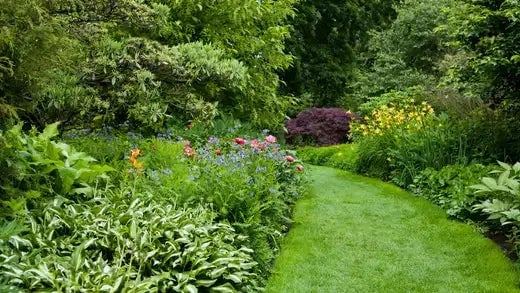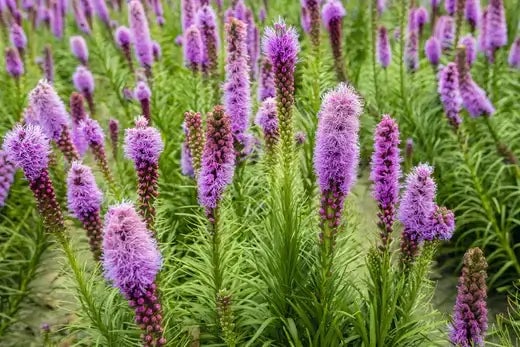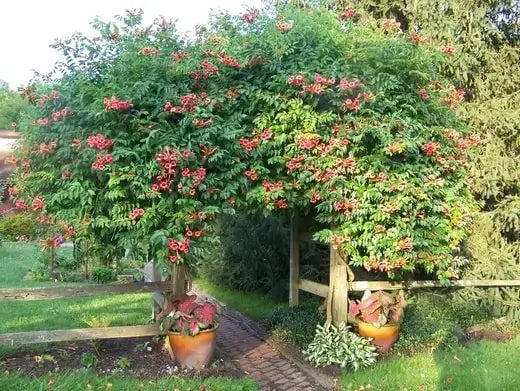Crossvine Plants: Beauty and Versatility in Your Garden
In ornamental vines, the crossvine (Bignonia capreolata) is a captivating and versatile plant that brings beauty and charm to gardens, landscapes, and outdoor spaces. With its unique characteristics, stunning blossoms, and ease of cultivation, the crossvine has become a favorite among garden enthusiasts and landscapers.
Crossvine Plants:
The crossvine, scientifically known as Bignonia capreolata, is a native North American vine that belongs to the Bignoniaceae family. This family also includes other well-known vines like trumpet vine and jacaranda. The crossvine earned its name from the cross-shaped cut that is visible when the stem is sliced, which is also the origin of its genus "Bignonia," named after Abbé Jean-Paul Bignon, a French Jesuit and botanist.
Physical Characteristics:
Crossvine plants are renowned for their attractive and distinctive appearance. They are vigorous, woody vines that can reach impressive heights of up to 50 feet or more. These vines are known for their clinging growth habit, which makes them ideal for covering walls, trellises, arbors, and fences, creating a natural and beautiful aesthetic in various outdoor settings.
The leaves of the crossvine are semi-evergreen, providing year-round visual interest. They are composed of two leaflets, resembling the shape of a butterfly. The foliage is glossy and profoundly green, creating a lush backdrop for the striking blossoms.
Blossoms that Mesmerize:
One of the most captivating features of the crossvine is its stunning blossoms. The plant produces trumpet-shaped flowers known for their vibrant and vivid hues. The color range includes shades of orange, red, yellow, and even apricot, adding a burst of color to any landscape. The flowers typically have a yellow throat and radiating lines that guide pollinators toward the nectar-rich center.
The blooming period of the crossvine typically occurs in late spring to early summer, providing a spectacle of color and fragrance that attracts hummingbirds, butterflies, and bees. This makes the crossvine an excellent choice for those looking to create a pollinator-friendly garden.
Cultivation and Care:
Crossvine plants are relatively easy to grow, making them suitable for both experienced gardeners and beginners. Here are some essential considerations for cultivating and caring for crossvine plants:
Sunlight:
Crossvines thrive in full to partial sun. While they can tolerate many shades, they bloom more profusely when exposed to ample sunlight.
Soil:
Well-draining soil is crucial for the health of crossvine plants. They can adapt to various soil types, but soil rich in organic matter is preferred.
Watering: During the establishment period, regular watering is important. Once established, crossvines are relatively drought-tolerant, but they will still benefit from consistent moisture, especially during dry spells.
Support: Crossvines require a sturdy support structure to climb on due to their clinging growth habit. Trellises, arbors, and fences are all suitable options.
Pruning: Pruning is essential to keep crossvines in check and encourage healthy growth. Prune after the blooming period to maintain a tidy appearance and control their size.
Fertilization:
Applying a balanced, slow-release fertilizer in the spring can help promote vigorous growth and abundant blooms.<>Pest and Disease: Crossvines are relatively resistant to pests and diseases. However, occasional checks for aphids, mealybugs, or leaf-spot diseases are recommended.
Landscaping and Design:
The versatility of crossvine plants makes them a valuable asset in landscaping and garden design. Here are some ways you can incorporate crossvines into your outdoor spaces:
- Vertical Accents: Crossvines are excellent for adding vertical interest to walls, fences, and other structures. Their vibrant blossoms and lush foliage create an enchanting tapestry that transforms ordinary surfaces into living works of art.
- Privacy Screening: Use crossvines to create a natural privacy screen, allowing them to grow on trellises or lattice panels. This adds beauty and enhances the sense of seclusion in your outdoor areas.
- Arbors and Entryways: Adorn arbors and entryways with crossvines to create a grand entrance. The cascading flowers and foliage add romance and elegance to these features.
- Wildlife Gardens: With their nectar-rich blossoms, crossvines are a boon for pollinators like hummingbirds and butterflies. Incorporate them into wildlife-friendly gardens to support local ecosystems.
- Container Gardening: While crossvines are primarily known as climbers, they can also be grown in large containers with appropriate support. This is an excellent option for small spaces or patios.
Cultivars and Varieties:
The world of horticulture has produced several cultivars and varieties of crossvine plants, each with unique characteristics and color variations. Some popular cultivars include:
'Tangerine Beauty': Known for its stunning tangerine-orange blossoms, this cultivar is a showstopper in any landscape.
'Dragon Lady': This variety is recognized for its reddish-orange flowers and more compact growth habit, making it suitable for smaller spaces.
'Atrosanguinea': Featuring deep red flowers, this cultivar adds a touch of drama and richness to garden designs.
Crossvine plants are a testament to nature's ability to provide both beauty and function in the garden. Their vigorous growth, captivating blossoms, and adaptability make them a valuable addition to landscapes of all types. Whether used as vertical accents, privacy screens, or pollinator magnets, crossvines have earned their place as a beloved choice among gardeners and landscapers. With proper care and cultivation, these vines will reward you with years of stunning displays and natural elegance in your outdoor spaces.
Companion Planting with Crossvine: Best Plant Allies
The climbing vine Bignonia capreolata stands out for its vigorous growth and trumpet-shaped flowers, which display vibrant orange to reddish tones. Crossvine thrives in USDA Zones 6 through 9 and grows naturally in the southeastern United States, where it is used to add dynamic vertical features to fences, arbors, and trellises. The cross-vine flower clusters pull in hummingbirds and additional pollinating species, making it perfect for gardens that support wildlife. Pair crossvine with these complementary companion plants to improve your garden's health and aesthetics.
Select perennials that support pollinators and grow well under conditions similar to your garden space. Coneflower (Echinacea purpurea), black-eyed Susan (Rudbeckia hirta), and bee balm (Monarda didyma) function as compatible companions with crossvine, which thrives in full sun to partial shade conditions alongside well-drained soil. The burst of vibrant colors from these perennials in midsummer creates a smooth transition following the fading blooms of crossvine in spring. The flowers act as magnets for bees, butterflies, and hummingbirds and simultaneously establish an energetic display of shapes and heights at your crossvine's foundation.
Ornamental grasses serve as a functional option for plant companionship. Native bunch grasses like little bluestem (Schizachyrium scoparium) and switchgrass (Panicum virgatum) contribute texture and movement while adding architectural interest to landscapes. The vertical structure of certain plants provides essential support for the thick vine leaves and enhances garden beauty. Ornamental grasses stabilize soil and hold moisture, which makes them an appealing base for vertical structures embellished with crossvine.
The base of the vine can be filled with shrubs that have either matching foliage or different textures to enhance the garden environment. Evergreen native shrubs such as inkberry holly (Ilex glabra) and southern wax myrtle (Myrica cerifera) provide continuous visual appeal throughout the year while defining the vine's climbing nature. The dark green foliage serves as a vibrant background that brings out the orange-red crossvine flowers through their contrasting colors, enhancing both plants' visual impact.
To further enhance your garden space, choose low-growing groundcovers or herbs that thrive in partial shade. Creeping thyme (Thymus serpyllum), ajuga (Ajuga reptans), and sweet woodruff (Galium odoratum) form a dense carpet of foliage under the crossvine and keep weeds away while maintaining soil moisture. The ground-level plants thrive under the filtered sunlight provided by the vine canopy and maintain soil temperature regulation, which becomes essential during the hot summer months.
The selection of cross-vine companion plants should include diverse species that draw beneficial insects and improve garden health. Introducing native wildflowers like Coreopsis (Coreopsis spp.) Gaillardia pulchella serves as a natural attraction for predatory insects, which then help to control pest populations. Multiple plant species with different bloom periods ensure pollinators receive continuous access to nectar and pollen during the growing season.
The most suitable plants to grow alongside crossvine thrive in well-drained soil and require moderate moisture while tolerating sun to partial shade conditions. Crossvine thrives when planted next to carefully selected plants, which provide biodiversity benefits and visual interest and require minimal maintenance. Combining color with texture and bloom periods results in a thriving ecosystem that showcases crossvine's natural beauty and supports the garden's overall health.
Read more

Ground covers are perfect for landscaping around sidewalks, patios, or anywhere there's not a lot of sun, and the ground needs something to landscape with that doesn't get very large. Periwinkle Gr...

Perennials Life Span Is Years Whereas Annuals Dies Every Fall After BloomingTN Nurseries best selling perennials1. Violets2. Trilliums3. Virginia bluebells4. Milkweed5. ConeflowerPerennials are pla...


